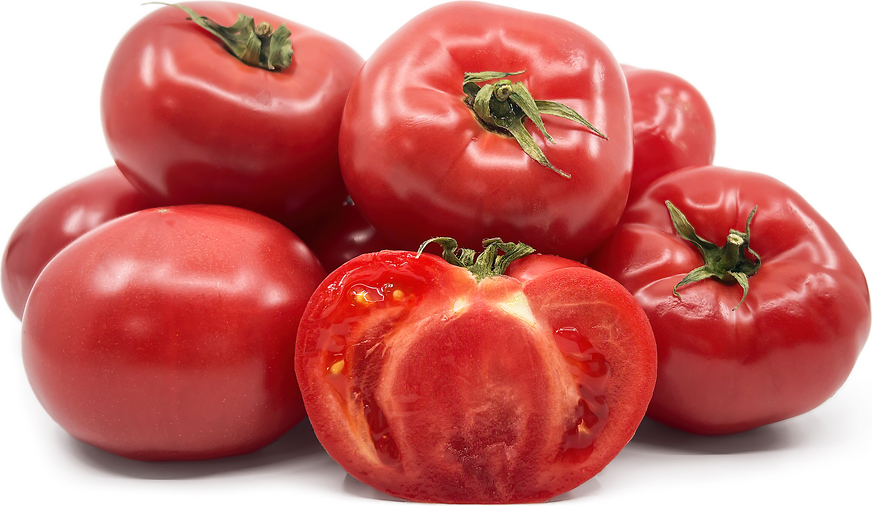


Moscow Tomatoes
Estimated Inventory, lb : 0
Description/Taste
Moscow tomatoes are a medium to large variety, averaging 7 to 10 centimeters in diameter, and have a round, oblate, and slightly flattened shape. The tomatoes range from 80 to 200 grams in weight, depending on growing conditions, and feature some ridges and creases surrounding the green stem cap. The skin is thick, smooth, taut, and glossy, showcasing deep red hues. Underneath the surface, the flesh is saturated red and has a dense, firm, and aqueous nature. Moscow tomatoes are tender, crisp, and succulent when eaten ripe and raw. Several chambers in the flesh also hold tiny, flat yellow seeds suspended in a gelatinous liquid. Moscow tomatoes are known for their rich flavor with balanced sugar and acidity, creating a savory, sweet, and umami-forward taste.
Seasons/Availability
Moscow tomatoes are available in the summer, typically in July and August.
Current Facts
Moscow tomatoes, botanically classified as Solanum lycopersicum, are a Russian variety belonging to the Solanaceae or nightshade family. The early to mid-season cultivar is a popular home garden tomato for its improved characteristics and balanced, sweet, and acidic flavor. Moscow tomatoes are a multi-purpose determinate variety and grow on low, compact bushes reaching 50 to 70 centimeters in height. Each plant produces around two kilograms of fruit per season and is known for consistent yields. Moscow tomatoes are ready for harvest approximately 95 to 100 days after germination and are somewhat disease resistant, making them easier to grow. Once harvested, Moscow tomatoes do not tend to crack and can be transported without damage. The variety is often grown for personal use in everyday, raw or cooked savory culinary preparations.
Nutritional Value
Moscow tomatoes have not been extensively studied for their nutritional properties. Tomatoes, in general, are a source of fiber to aid digestion and contain minerals like copper, manganese, potassium, magnesium, phosphorus, and calcium. Copper helps the body make red blood cells, manganese contributes to metabolism, while potassium balances fluid levels. Magnesium assists the body in controlling nerve functions, while phosphorus and calcium support bone and teeth development. Tomatoes also provide vitamins A, B, C, E, and K for energy production, faster wound healing, healthy organs, protecting against free radical damage, and strengthening the immune system.
Applications
Moscow tomatoes have a savory-sweet taste suited for fresh and cooked preparations. The variety has balanced sugar to acid ratios, making it a flavorful choice for salads. Moscow tomatoes are also chopped and served on bruschetta, layered into sandwiches, or diced and added to fresh dips and condiments. In addition to leaving the variety whole or chopping, Moscow tomatoes are popularly juiced into fruit and vegetable beverages or used as a base flavoring for some cocktails. They are also incorporated into chilled soups like gazpacho. In Russia, Moscow tomatoes are simmered into sauces, including homemade ketchups, or cooked into pastes as bases for borscht and stews. Tomatoes are also incorporated into cabbage rolls, stuffed and roasted, or cooked in casseroles and main dishes. Beyond fresh uses, Moscow tomatoes are pickled into a tangy condiment. Pickled tomatoes are a traditional Russian preservation method and are added to plov, or rice pilaf, served on salads, displayed on cheese boards, or cooked into dishes. The brine from pickling is called rassol in Russia and is used to make a soup or is culturally drunk as a hangover cure. Moscow tomatoes are also used in canning and dried for extended use as a chewy snack or salad topping. Moscow tomatoes pair well with aromatics like garlic and onions and herbs such as dill, basil, parsley, and cilantro. Whole, unwashed Moscow tomatoes will keep for a few days when stored at room temperature in a cool, dry, and dark location. Sliced or cut tomatoes should be placed in a sealed container and stored in the fridge.
Ethnic/Cultural Info
Moscow tomatoes are just one of several tomatoes developed by Lyubov Anatolyevna Myazina, a famous Russian breeder. Lyubov Myazina acquired experience in breeding through her career at the Moldavian Research Institute of Irrigated Agriculture in Tiraspol, Moldova. During her time at the research institute, she worked closely and learned from Professor Lyudmila Ivanovna Guseva, a well-known Doctor of Agricultural Sciences. Myazina spent years breeding tomatoes, cucumbers, and peppers, and solely used methods of natural selection in her work. No genetic modification was used in her crosses. Currently, Myazina has released twenty-five varieties of tomatoes for gardens, thirty-nine hybrid tomatoes created for processing, and seven varieties of cucumbers. All the varieties are included in the Russian Federation’s State Register and are cultivars known for their flavor and growth characteristics. Myazina’s breeding plot is located in the Moscow region, the capital of Russia, and also the city that the variety was named after.
Geography/History
Moscow tomatoes are native to Russia and were developed sometime in the late 20th or early 21st century. Much of the variety’s history is unknown other than that it was created by breeder Lyubov Anatolyevna Myazina. Moscow tomatoes were included in the Russian Federation’s State Register in 2007 and were commercially released as an improved home garden cultivar. Today, Moscow tomatoes are a common variety throughout Russia and are found through select growers in Central Asia and Eastern Europe. The variety is also offered through seed companies in the United States. When in season, Moscow tomatoes are sold through fresh markets. The Moscow tomatoes featured in the photograph above were sourced through a market in Kazakhstan.




